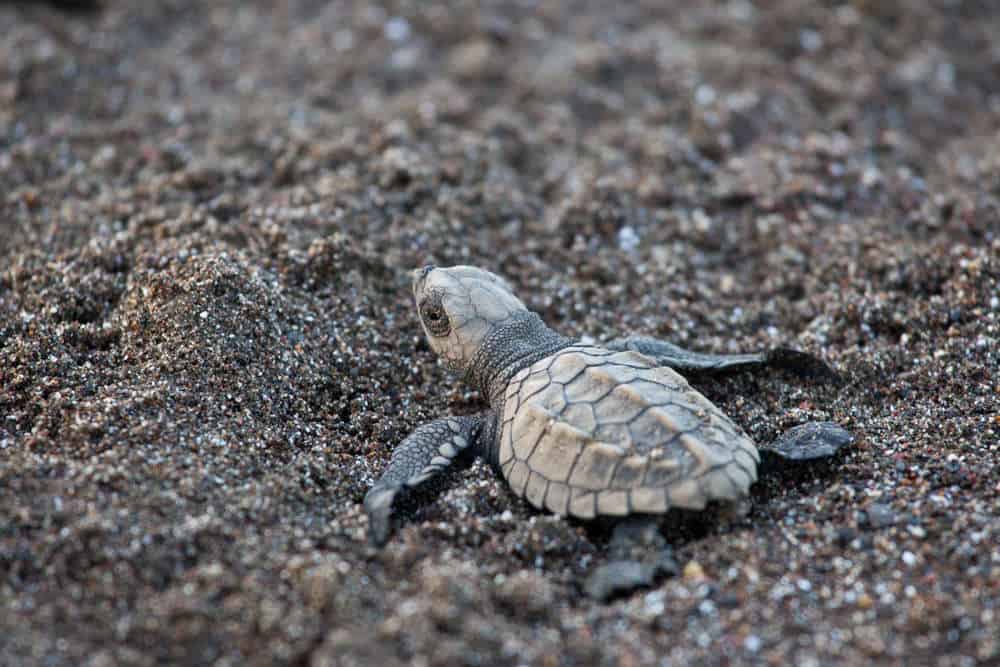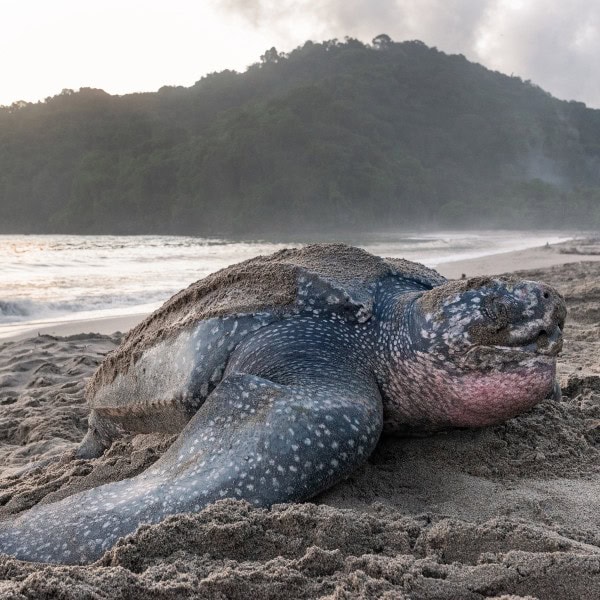Support sea turtle conservation worldwide by adopting a sea turtle today.
You can support Oceanic Society’s global sea turtle conservation programs by adopting a sea turtle species or naming a leatherback sea turtle today. Oceanic Society supports local sea turtle conservation programs worldwide, including efforts to protect nesting beaches, address plastic pollution, improve fishery management, support sustainable livelihoods, and much more.
Your symbolic sea turtle adoption or sea turtle naming with Oceanic Society not only makes a great gift, but it also provides support to our sea turtle conservation programs. Oceanic Society is a U.S. 501(c)(3) non-profit organization (EIN: 94-3105570), and your symbolic animal adoptions are tax-deductible.
Adopt or name a sea turtle today by choosing from the options below!

Adopt a Sea Turtle
For 1 Year: $50
For a tax-deductible annual adoption feeof $50 you will receive:
- A personalized printed or digital certificate of adoption good for one year.
- Free domestic shipping via USPS, on request (note: international orders will receive a digital certificate).
Name a Leatherback
Turtle: $500
For a tax-deductible fee of $500, you can name a leatherback sea turtle tagged on Matura Beach in Trinidad and Tobago. Your donation will support Nature Seekers, the nonprofit conservation group responsible for protecting and collecting data on your named turtle. You will also receive:
- A personalized naming certificate with information collected by Nature Seekers about your sea turtle.
- A leatherback turtle fact sheet and information about the work you are supporting.
- Free shipping worldwide, upon request.
- Public acknowledgment on our Named Sea Turtles page and in Nature Seekers’ annual report.
- Permanent recognition as the leatherback’s patron in Nature Seekers’ database.
- Email updates about re-sightings of your turtle and new data collected (if available).

Sea Turtle Species Available for Adoption

Leatherback Sea Turtle
Common Name: Leatherback turtleScientific Name: Dermochelys coriacea
IUCN Red List Status: Vulnerable
Adult Length: 4.5 to 6+ feet (140-180+ cm)
Adult Weight: 661 to 1,410+ lbs (300-640 kg)
The largest of the sea turtles, leatherback turtles are superlative in many ways. They make the longest migrations of any sea turtle and among the longest migrations of any vertebrate, sometimes crossing entire ocean basins just to feed. For example, leatherback turtles that breed and nest in West Papua, Indonesia swim across the Pacific Ocean to feed on abundant jellyfish off the coast of California and Oregon-more than 12,000 miles! Leatherbacks also make the deepest dives of any sea turtle, regularly diving to depths greater than 1,000 m (3,281 ft) where no sunlight reaches. These spectacular animals are threatened with extinction worldwide, and are rapidly declining in many parts of the world.
Adopt
Green Sea Turtle
Common Name: Green turtleScientific Name: Chelonia mydas
IUCN Red List Status: Endangered
Adult Length: 2.6 to 4 feet (80-120 cm)
Adult Weight: Up to 661lbs (300 kg)
The most iconic of the sea turtles, the green turtle also has the most numerous and widely dispersed nesting sites of the seven species. As adults, green turtles are mainly herbivores and are known to play an important role as “grazers” in seagrass ecosystems. Green turtles were formerly one of the most abundant large vertebrates in the ocean, but populations have declined dramatically over the past several hundred years, leaving them as endangered globally. Green turtles were once highly sought after for their body fat – a key ingredient in the popular delicacy, ‘green turtle soup.’ Although it has become illegal to catch and trade them in many parts of the world, green turtles and their eggs continue to be eaten, and face newer threats from fishing, coastal development, and climate change.
Adopt
Hawksbill Sea Turtle
Common Name: Hawksbill turtleScientific Name: Eretmochelys imbricata
IUCN Red List Status: Critically Endangered
Adult Length: 2.5 to 3 feet (75-90 cm)
Adult Weight: Up to 331 lbs (150 kg)
Named for their sharp, pointed beaks, in most parts of the world hawksbill turtles feed primarily on reef sponges-invertebrate organisms whose bodies contain tiny, indigestible glass needles. Hawksbills are therefore most often found in close proximity to coral reefs. The hawksbill’s scientific name, imbricata, refers to the overlapping nature of the scutes (scales) on its shell. They have beautiful, translucent shells that have long been exploited for use in tortoiseshell jewelry. Though international trade of tortoiseshell has been prohibited, illegal trafficking continues, and hawksbills are Critically Endangered with extinction.
Adopt
Olive Ridley Sea Turtle
Common Name: Olive ridley turtleScientific Name: Lepidochelys olivacea
IUCN Red List Status: Vulnerable
Adult Length: 2 to 2.3 feet (60-70 cm)
Adult Weight: Up to 154 lbs (70 kg)
Far and away the most abundant sea turtle species, olive ridleys are known for their amazing mass nesting behavior. In one of nature’s greatest spectacles – known as arribadas, the Spanish word for ‘arrival’ – olive ridleys come ashore simultaneously by the thousands to nest. These phenomena occur in just a handful of places worldwide, including Costa Rica, Nicaragua, Mexico, and India. Though olive ridleys are the most abundant of sea turtles, they are also threatened by fisheries bycatch, egg harvest, and coastal development.
Adopt
Kemp’s Ridley Sea Turtle
Common Name: Kemp’s ridley turtleScientific Name: Lepidochelys kempii
IUCN Red List Status: Critically Endangered
Adult Length: 2 to 2.3 feet (60-70 cm)
Adult Weight: Up to 132 lbs (60 kg)
The Kemp’s ridley is the smallest of the sea turtles, and also the most endangered. It has a restricted range, nesting only along the Gulf of Mexico shores of northern Mexico and in Texas, U.S.A. Fifty years ago, the Kemp’s ridley nearly went extinct. Although this species now shows signs of recovery thanks to a long-term, dedicated multinational conservation effort, its population is still only a small fraction of what it was when it was first discovered in the 1940s. Unlike most sea turtle species, Kemp’s ridleys nest during the day.
Adopt
Loggerhead Sea Turtle
Common Name: Loggerhead turtleScientific Name: Caretta caretta
IUCN Red List Status: Vulnerable
Adult Length: 2.3 to 3.6 feet (70-110 cm)
Adult Weight: Up to 441 lbs (200 kg)
Loggerhead turtles are the most common and abundant species nesting in the United States. During the spring and summer, they nest on beaches throughout the southeast U.S. (from North Carolina south through Florida) and into the Gulf of Mexico. Loggerheads are named for their large heads, with jaws powerful enough to crush an adult queen conch (a favorite food). They are known for their vast migrations, among the longest of the sea turtles. For instance, loggerhead turtles that nest in Japan migrate across the Pacific Ocean to feed in the waters of Mexico! As a species that can travel thousands of miles across ocean basins, loggerheads are also threatened due to habitat loss, pollution, and accidental capture by fishermen.
Adopt
Flatback Sea Turtle
Common Name: Flatback turtleScientific Name: Natator depressus
IUCN Red List Status: Data Deficient
Adult Length: 2.6 to 3.1 feet (80-95 cm)
Adult Weight: Up to 220 lbs (100 kg)
The flatback turtle is the least studied of the sea turtles and has one of the smallest geographic ranges. In fact, until 1988 flatbacks were thought to be a subspecies of green turtle rather than a separate species. Flatbacks nest solely along the northern coast of Australia, and live on the continental shelf between Australia, southern Indonesia, and Papua New Guinea. These unique turtles have the largest eggs and hatchlings relative to their adult body size of all sea turtles, and they have a unique physiology that allows them to stay active underwater for longer periods than most other species.
AdoptLeatherback Sea Turtles Available For Naming
 PIT Tag ID: AVID*032*071*818
PIT Tag ID: AVID*032*071*818First Tagged: May 22nd, 1999
Most Recent Sighting: March 18th, 2024
Number of Years Seen Nesting: 5
Leatherback turtle AVID032101*008 holds the record for wearing her tag longer than any other turtle in our system. First tagged in 1999, she returned to Matura in 2001, 2005, 2007, and, after a 17-year hiatus, again in 2024-marking 25 years of remarkable migrations between her nesting beach and foraging grounds off Nova Scotia, all under the same ID. Now, in honor of 25 years with her tag, she’s ready for a new name.
Name